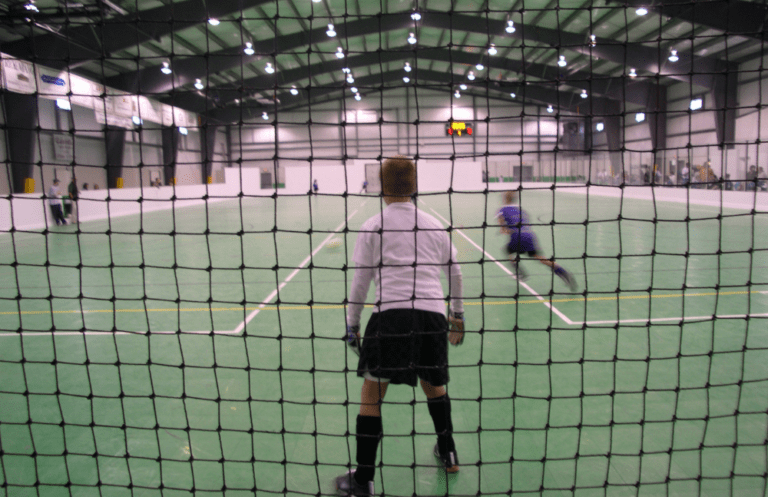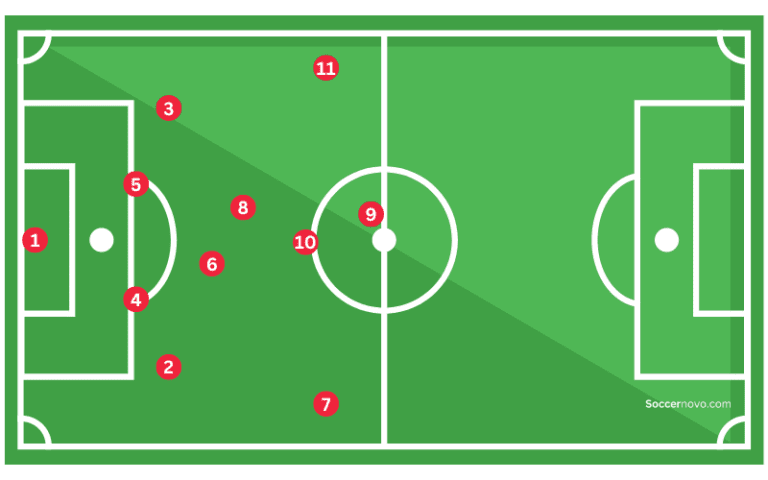How to Get in Soccer Shape

When was the last time you looked at a professional soccer player and thought, “Wow, this player looks so out of shape!” It’s probably very rare!
Unlike the need for a big, strong body to succeed as a lineman in football or a 7-foot height advantage in basketball, being a lean, athletic, and fit individual is far more important in soccer. Soccer players have a distinct physical appearance because of the rigorous training they undergo to prepare for the game.
Key Takeaways From This Article:
- Soccer players need to be physically fit in order to run for 90 minutes per game. There’s very little stoppage and each player usually has to play both sides of the ball at certain moments.
- Any player can improve their fitness and endurance. Here are some exercises.
- The pre-season is when you can really accelerate your fitness.

In this article, we’ll address how to get in soccer shape and things to keep in mind.
How Do You Train for Soccer?
It’s no secret 🤐 that you need to work on your conditioning if you want to maximize your soccer abilities.
Your cardiovascular fitness and strength can be improved, your nutrition can be optimized, and your bad habits can be thrown out the window. Simple adjustments to your daily routine can significantly impact how well you play soccer.
In the following sections, we’ll explain what it takes to get in shape for soccer, from diet and exercise to mental preparation, and what you can do to ensure you’re at your best.
Start Working Out for Soccer
When it comes to getting into soccer condition, planning a workout routine is helpful. And, simply starting is the big first step.
There are several options where to work out:
- At home
- Nearby gym
- Outside
The easiest way to work out at home is by putting on a guided YouTube video and following along for 30 minutes. These are fun exercises you can do in the comfort of your home. Doing these consistently can really improve your overall health.
For older youth and adult players, the local gym is a great place to improve your fitness in many ways including cardio and weight lifting. Many soccer facilities now have a strength and training section where players can incorporate weightlifting into their weekly training regime.
When working out at a gym, try to go 2-3 times a week and focus each session on different muscle groups. For example, Monday can be chest and triceps, Wednesday is back and biceps and Friday is leg day. This helps concentrate your workouts while letting each muscle group have rest days.
Moreover, getting creative and working out outside can be more fun than being stuck indoors. Weather-dependent, players can create their own workout routines that fit their schedule. For example, one day could be running 3 miles down the road. Another day could be going to the local park to do pull ups and agility exercises. The next day can be running up and down the bleachers along with 3 steps of calf raises.
Whichever route you choose, starting is the key. Don’t overcomplicate your routines. Even 20 minutes is better than zero.
Work on Your Endurance
Keeping a high level of aerobic fitness has proven to be beneficial for performance in team sports. This is especially true in soccer where players have to run 60 to 90 minutes each game.
Therefore, to get in better shape and compete on the soccer field, you must engage in aerobic activity.
Depending on your current level of fitness, an aerobic fitness program of 4–10 weeks can substantially impact your performance on the field.
You may improve your cardiovascular health and soccer performance by participating in aerobic workouts like jogging, cycling, jump roping, and swimming during the offseason.
Consider HIIT Exercises
High-intensity interval training (HIIT) is a widely practiced method of getting in better shape. Research shows that HIIT is beneficial for more than just weight loss. They look like this…
The concept behind high-intensity interval training is to work hard for shorter durations. Most HIIT routines last a little more than 15 minutes, but the intensity is substantially higher than other workout routines.
HIIT can be beneficial for soccer because:
- After completing a HIIT workout, your metabolism will continue to be elevated for several hours.
- Regular HIIT training might help you shed unwanted pounds more quickly.
- HIIT can aid muscle preservation depending on the type of exercise you do.
- You may increase your oxygen consumption by doing HIIT.
Focus on Your Preseason Training
While most youth soccer players use the offseason as an opportunity to relax and spend time with their friends, it is also essential for the team to come together to prepare for the upcoming season.
In most cases, the preseason will begin four to six weeks before the start of the first regular season game.
During these weeks, soccer players often prioritize physical conditioning over technical skill development.
It is important to take advantage of this time so you are prepared for the new season. If you don’t, you’ll spend the beginning of the season trying to catch up and find it challenging to perform at the same level as the rest of your team. The choice is yours!
Don’t Shortcut Soccer Practice!

It should go without saying, but… However, many athletes believe they can just show up on game day and have a strong performance. Maybe you can but probably not consistently.
Nevertheless, the fact is that soccer players spend the majority of their time doing the most crucial work on the training field. A team’s preparation includes not only strategizing and arranging formations but also physical conditioning drills.
Missing a few training sessions here and there might negatively affect your conditioning. I’ve personally seen it when families take vacations. Their child comes back a week later and is huffing and puffing all over the field. Don’t get me wrong, family vacations are great but they can temporarily set back players.
Make it a priority to not only attend soccer practice regularly but push yourself at all times. Over the course of the season, these training sessions will compound over time.
Play Small-Sided Soccer as Much as You Can

To improve your fitness and overall game, regularly play small-sided soccer as much as you can.
Small-sided soccer games are typically intense and fast-paced since the ball doesn’t go out of play as often as in 11-a-side competitions.
Most teams also use a tactic known as “player-to-player marking,” which requires each player to shadow their opponent wherever they go on the field constantly.
In addition to providing fantastic exercise, playing soccer in a small-sided format is loads of fun and can provide players an outlet to play faster!
Improve Your Diet
Eat food to fuel your body and not to satisfy your desire.
When it comes to getting healthy, what you eat is just as crucial as how often you work out. Consuming excessive refined carbs, processed meals, or sugary snacks is bad for your long-term health.
Therefore, if you want to get in better shape for soccer, it may be time to change your diet.
Start eating whole, unprocessed foods such as fruits and vegetables. Include lean protein sources in your meals, like fish, eggs, and legumes. And be sure to get plenty of complex carbohydrates like oats or quinoa for energy.

There is no one set food plan that would guarantee you the best performance on the field. Making healthier food choices and continuing a lifestyle is your best path! I’m living proof of this. I used to work out more than the average person but was always tired. As soon as I changed my diet, my energy levels skyrocketed, my mind became sharper, and I was able to maximize my fitness.
Although eating properly isn’t very complicated, it might be challenging to establish healthy eating habits. That’s why it’s important to take it gradually and make little adjustments as you work to improve your nutrition.
Be Sure To Hydrate Well
Staying hydrated is almost as important as eating healthy. This is especially true during the workouts and training sessions.
According to studies, more than half of Americans don’t drink enough water. This is detrimental to your health, well-being, and performance as a soccer player.
You need to replace the fluids you lose through sweating since around 60% of your body is water.
If you don’t drink enough water, you might get dehydrated. When you’re dehydrated your body doesn’t function well and you may get light-headed.
It goes without saying that you can’t perform at your best on the soccer field if you’re dehydrated.
Put an End to Your Negative Routines

To sum up, if you can kick certain negative habits and replace them with positive ones, you’ll see a significant uptick in your health and soccer play.
Obviously, we’re not encouraging you to deprive yourself of any enjoyment, but there are some activities you’ll need to scale back on if you want to be in the best shape of your life this year.
Getting in soccer shape is fairly straightforward, let’s not overcomplicate it. If you do 3 out of 5 of these things, you’ll be much better off:
- Workout
- Eat healthy
- Drink lots of water
- Play as much as you can
- Rest and repeat
How Long Does It Take To Peak Conditioning?
Your present fitness level, mental readiness, and technical expertise all play a role in how quickly you can attain your fitness goals.
The more ideal these conditions are, the less complicated they will be. In general, around four to six weeks is the minimum for making progress and seeing significant improvements in your health.
It’s important to prepare for this time period with regular exercise and healthy eating habits.
During this period, you will gradually improve your physical abilities, such as strength, speed, stamina, and coordination. You may not notice today or tomorrow but, someday, you’ll look back and realize it was all the little habits that made a big difference.
A Few Quick Tips for Getting in Shape
Exercising with a purpose without wearing yourself out is the best way to get into great soccer shape. Such commitment is necessary if you want to succeed at the highest level.

You don’t have to train for hours on end. For youth players, try to keep your workouts around 30 minutes to an hour.
Consistency is key but have a rest day or two.
For example, your weekly schedule could look something like this…
- Monday: Run 3 miles / 20 pushups
- Tuesday: Jump rope for 10 minutes / HIIT exercises for 30 minutes / stretch for 10 minutes
- Wednesday: Ball work for 30 minutes / Agility training for 10 minutes
- Thursday: Rest day
- Friday: Run and sprint for 3 miles / 20 pushups
- Saturday: Yoga and stretching for 45 minutes
- Sunday: Rest day
It’s important to listen to your body. Be okay to rest if you are too exhausted to workout on a day you have something planned.
Remember to have a long-term view. Overdoing your workout routines could cause injury and minor aches and pains.
Conclusion
If there was a magic formula for getting in shape in under 20 minutes, everyone would do it. For this reason, it’s good that there is no secret or shortcut. You can put yourself at an advantage over other players by doing the basics: working out regularly and eating healthy.
Use these tips as a starting point to improve your overall physical fitness.
Don’t forget, the most important thing is that you get started and never give up. Keep moving forward, and don’t look back! You got this 💪
Common Questions
To get better in soccer shape, players can do workouts at home. Simple exercises like situps, pushups, and lunges will help players improve their strength. Workouts like a HIIT program can also help athletes get in better shape.
Being in good shape certainly helps in soccer. Soccer is a physically demanding sport that requires a good level of fitness and endurance. Players need to be able to run, sprint, jump, change directions quickly, and maintain their stamina throughout the game.
A soccer player’s diet should consist of a balance of carbohydrates, protein, and healthy fats to provide the energy and nutrients necessary for optimal performance and recovery. Also, players should try to avoid alcohol, processed foods, and sugary snacks.

Written By: Beau Bridges
Beau is the founder of SoccerNovo, dedicated to helping players and parents navigate the youth soccer landscape. As a former youth coach and soccer parent, he shares insights on player development, recruiting, and the ever-evolving soccer scene in the U.S.
Let’s connect





